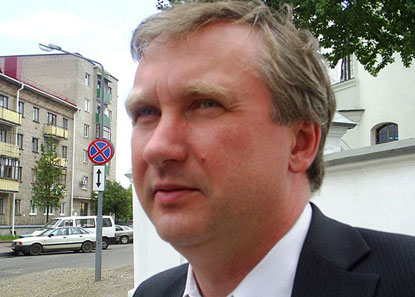Lawyer Pavel Sapelka describes nuances of penitentiary statistics
Last week, there were voiced opposite statements about the number of prisoners in Belarus. One of the calculations was voiced by President Lukashenka, the other – by the Internet newspaper “Salidarnasts”. Human rights defenders react to the both of them with reasonable skepticism.
Pavel Sapelka, an expert on the penitentiary system, notes that one of the most important moments in such calculations is that in order to receive a more or less objective outlook one needs to clearly understand which things can be compared and whether such comparison is appropriate and justified.
"The attitude to prison statistics and data characterizing the crime in a separate state can be different. Of course, decrease in the number of prisoners is a good trend that allows talking about humanization of the sphere as a whole. If the decline in the number of prisoners is not accompanied by an increase in crime rates – this is twice as good and shows the correctness of the chosen direction.
July 7, 2014, optimistic statements were made at a meeting on the draft law, which provides for changes in the criminal and criminal procedural legislation, such as that the number of prisoners will become twice smaller. Well, not bad. However, as always, the relevant data about the number of prisoners remained a secret. Or somebody may have forgotten to announce them.
Sure, Belarus knew much harder times: in 1992, when there were 33,641 prisoners, this figure grew and in 1995 there were 54,869 people in 1998 - 63,157 in 2001 - 55,156. Having declined to 42,806 in 2004, the number of imprisoned remained at the level of 40-46 thousand people until 2010 [i]. At the end of 2012, Belarus had 28,841 prisoners [ii]. This number does not include those who served a sentence in the form of restrictions on freedom, were kept in activity therapy centers, were sentenced to administrative arrest or underwent forcible medical treatment on court decision.
However, given the data for October 1, 2012 – 31,700 prisoners, i.e. 335 prisoners per 100,000 of the population, Belarus firmly holds the second place in Europe on this indicator after Russia, with its 470 prisoners per 100,000 inhabitants. Belarus occupies the 25th place out of 222 in the world ranking [iii].
The data about the crime rates are closely connected to these indicators.
In the period before the independence in 1990, the crime rate, compared to the current one, was quite favorable: in 1971 it revealed 33,318 crimes in 1980 – 45,404. In 1991, there were already 81,346 and in 1995 – 131,761 [iv]. However, the peak of crime was yet to come: in quite prosperous 2005 there were about 192,500 crimes, and in 2006 – 191,468. By 2014, the number of reported crimes and of persons who have committed them, was falling steadily: in 2007 there were registered 180,427 crimes in 2012 – 102,127, in 2013 – 96,676 The number of murders and attempted murders decreased from 1,117 in 1995 to 410 in 2013 [v].
Reduction the quantities is clearly visible, but it is unclear to which extent it witnesses an improvement of the situation. There may be many reasons for change of the indicators. For instance, it is difficult to make any opinion about the number of prisoners in the Soviet-time Belarus, as almost a half of them served their terms outside the republic. At the end of the 1950-ies Belarus had some 9-10 thousand prisoners per 7.7 million of population [vi]. Since independence, convicts were directed to serve their sentences on the territory of Belarus. Simultaneously, prisoners from the former Soviet countries were sent home.
The situation with crime rate is similar. If the level rises – it may also indicate an improvement of the registration of information about the cases, as well as a real increase in the number of crimes. Similarly, a drop in crime may be the result of mitigating the criminal and procedural law, in which a number of illegal acts simply migrates to the sphere of administrative offenses or is resolved without government intervention. In particular, since 2010, the Criminal Code and the Criminal Procedure Code introduced rules to avoid criminal responsibility for certain crimes in the case of reconciliation of the accused and the victim (to date criminal proceedings can not be instituted, and in the case of bringing shall be terminated in the case of reconciliation of the victim of the crime and the defendant, except when the prosecutor initiates proceedings in the absence of the statement of the victim of a crime, if it affects the essential interests of the state and society, or is committed against a person who is in the service or otherwise dependent on the accused or otherwise unable to defend their rights and legitimate interests).
All this deserves the attention of criminologists who can compare even more data, in particular the socio-economic indicators in the respective years, in order to come to a clear understanding of the reasons that affect the crime rates.
Moreover, the decrease in the number of prisoners must be accompanied by an improvement of their conditions in prisons in terms of respect to their civil, social and economic rights. Otherwise, it may seem like a trivial failure of the State to be the protector of the public interest.
[I] International Center for Prison Studies, http://www.prisonstudies.org
[II] offenses in the Republic of Belarus. Statistical compilation. Minsk, 2013
[III] International Center for Prison Studies
[IV] G.G.Shihantsov. Criminology. Minsk, 2006.
[V] http://mvd.gov.by
[VI] G.G.Shihantsov. Criminology. Minsk, 2006.


















